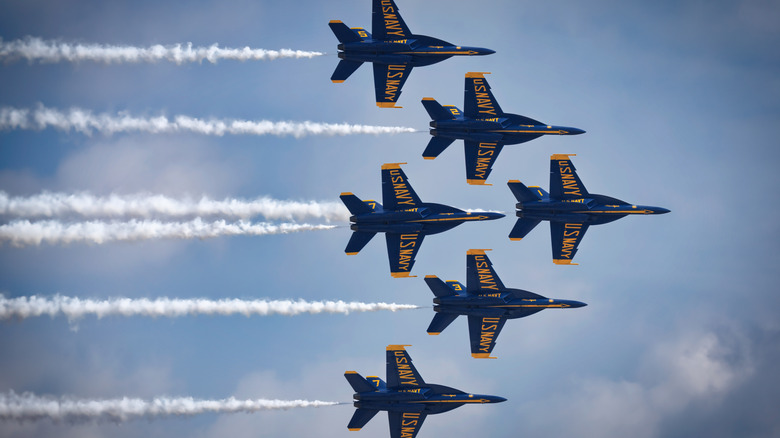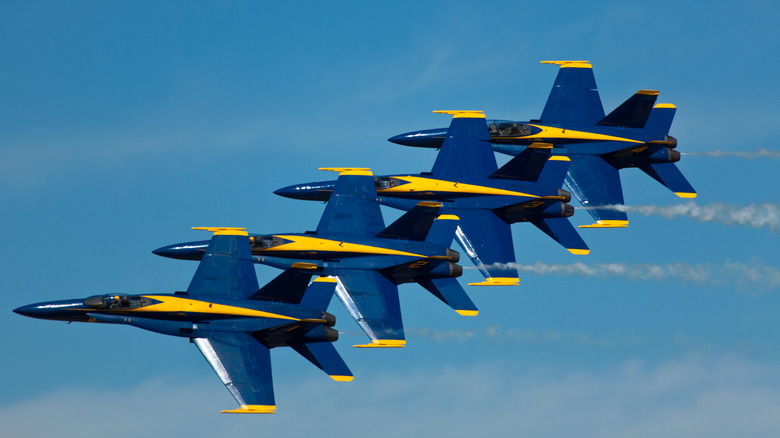Do The Blue Angels Go To War? The Elite Flying Team's Duties, Explained
The Blue Angels are ambassadors for the United States Navy with a mission to showcase a culture of excellence and inspire civilians to serve their country. Duties include community outreach, making appearances, and performing the team's signature flight demonstrations, all of which shine a spotlight on the teamwork and professionalism of the Navy and Marine Corps.
These pilots don't go to war, but the planes they fly (currently Boeing F/A-18 Super Hornets, one of the 17 best fighter jets in the world) can be onboard an aircraft carrier and ready to roar into battle within 72 hours. Pilots don't go into combat (and the team doesn't have a "spare pilot") because of the arduous training required. During the offseason (January, February, and March), each pilot must complete a minimum of 120 training flights at the Naval Air Facility in El Centro, California, to hone the flawless maneuvering that often brings the planes within 18 inches of each other. In fact, aviators must be aircraft carrier-qualified tactical jet pilots with a minimum of 1,250 flight hours just to apply to join the Blue Angels.
During the season, the team is stationed at the Naval Air Station in Pensacola, Florida. A total of 16 officers serve with the Blue Angels for typically two to three years, while enlisted personnel serve three to four. Since 1946, the squadron has had over 260 demonstration pilots and 37 flight leaders/commanding officers, losing 26 during its history. Lieutenant Commander Amanda Lee (call sign "Stalin") became the first female fighter pilot in the squadron in September 2022, and 24 women currently serve with the team. While it's not a requirement for pilots to go through the Navy Fighter Weapons School (TOPGUN) — a school which has a fascinating history — some have.
How often do the Blue Angels perform?
This elite flight demonstration squadron was first authorized by Admiral Chester W. Nimitz (chief of naval operations) in April of 1946, and the team's first show took place a few months later at Craig Field in Jacksonville, Florida, on June 15, 1946. (This is one of several interesting facts about the Blue Angels.) The team have been flying at shows ever since, inspiring people all over the country thanks to the squadron's skill, accuracy, and determination.
According to the Navy, more than 11 million people see the squadron's air shows every year. (The Blue Angels also interact with a further 50,000 people through visits to hospitals and schools.) In order to reach such a wide audience, the Blue Angels perform more than 60 demonstrations per year. However, these demonstrations are canceled if the flight leader/commanding officer gets sick or injured.
The precision aerial acrobatics of the Blue Angels is a sight to behold. I'm fortunate enough to live in the San Francisco Bay Area where the team routinely performs during Fleet Week (which is held in October to celebrate the United States Navy). These performances go ahead as long as the unpredictable fog cooperates and doesn't force a cancellation (which happened in 2024). That's because the team requires at least three nautical miles of visibility with a minimum cloud ceiling of 1,500 feet. Given the daring acrobatics the Blue Angels perform, great visibility is an absolute must.

